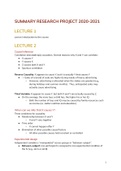Class notes
Summary of the lectures and workshops - block 7 BT2103 Research Project
- Course
- Institution
A complete and coherent English summary of the lectures and workshops of Research Project (BT2103) in block . Includes some examples of the given slides.
[Show more]



